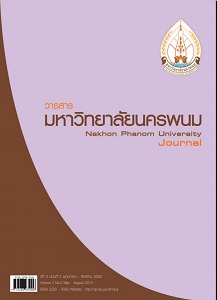การเปรียบเทียบผลสัมฤทธิ์ทางการเรียน ความสามารถในการคิดวิเคราะห์ ของนักเรียน ชั้นมัธยมศึกษาปีที่ 4 เรื่อง การเคลื่อนที่ในหนึ่งและสองมิติระหว่างการจัดการเรียนรู้ แบบวัฏจักร 7 ขั้น และการจัดการเรียนรู้แบบกลุ่มร่วมมือ TAI
Main Article Content
Abstract
การวิจัยครั้งนี้มีวัตถุประสงค์เพื่อ 1) เปรียบเทียบผลสัมฤทธิ์ทางการเรียนระหว่างการเรียนรู้แบบวัฏจักร 7 ขั้น กับแบบกลุ่ม ร่วมมือ TAI 2) ศึกษาเปรียบเทียบความสามารถในการคิดวิเคราะห์ระหว่างการเรียนรู้แบบวัฏจักร 7 ขั้น กับแบบกลุ่มร่วมมือ TAI 3) ศึกษาความพึงพอใจของนักเรียนชั้นมัธยมศึกษาปีที่ 4 ที่เรียนตามการเรียนรู้แบบวัฏจักร 7 ขั้น และแบบกลุ่มร่วมมือ TAI ประชากร ได้แก่ นักเรียนชั้นมัธยมศึกษาปีที่ 4 ภาคเรียนที่ 1 ปีการศึกษา 2554 โรงเรียนนาแกสามัคคีวิทยา อำเภอนาแก จังหวัดนครพนม จำนวน 289 คน จำนวน 7 ห้องเรียน กลุ่มตัวอย่างได้มาโดยการสุ่มแบบกลุ่ม ได้แก่ นักเรียน ชั้นมัธยมศึกษาปีที่ 4/1,4/7 จำนวน ห้องละ 42 คน จัดการเรียนรู้แบบวัฏจักรการเรียนรู้ 7 ขั้นและแบบกลุ่มร่วมมือ TAI ตามลำดับ เครื่องมือที่ใช้ในการวิจัยได้แก่ แผนการจัดกิจกรรมการเรียนรู้ เรื่อง การเคลื่อนที่ในหนึ่งและสองมิติ ชั้นมัธยมศึกษาปีที่ 4 แบบวัฏจักรการเรียนรู้ 7 ขั้น และแบบกลุ่ม ร่วมมือ TAI จำนวน 9 แผน มีประสิทธิภาพเท่ากับ 82.25/80.95 และ 83.55/81.55 ตามลำดับ และมีประสิทธิผลเท่ากับ 0.7626 และ0.7661 ตามลำดับ แบบทดสอบผลสัมฤทธิ์ทางการเรียนชนิดเลือกตอบ 4 ตัวเลือก 40 ข้อ มีค่าความเชื่อมั่นทั้งฉบับ 0.91 แบบทดสอบการคิดวิเคราะห์ ชนิด 4 ตัวเลือก 30 ข้อ มีค่าความเชื่อมั่นทั้งฉบับ 0.90 แบบสอบถามความพึงพอใจ 20 ข้อ มีค่าความเชื่อมั่น ทั้งฉบับ 0.84 สถิติที่ใช้ในการวิเคราะห์ข้อมูล ได้แก่ ร้อยละ ค่าเฉลี่ย ส่วนเบี่ยงเบนมาตรฐานและทดสอบสมมติฐานโดยใช้สถิติ ทดสอบที t-test (Independent Samples) ผลการวิจัยปรากฏ ดังนี้ 1) นักเรียนที่เรียนโดยใช้การเรียนรู้แบบวัฏจักร 7 ขั้น และแบบ กลุ่มร่วมมือ TAI มีผลสัมฤทธิ์ทางการเรียนไม่แตกต่างกันอย่างมีนัยสำคัญทางสถิติ 2) นักเรียนที่เรียนโดยใช้การเรียนรู้แบบวัฏจักร 7 ขั้น และแบบกลุ่มร่วมมือ TAI มีความสามารถในการคิดวิเคราะห์ไม่แตกต่างกันอย่างมีนัยสำคัญทางสถิติที่ระดับ .05 3) นักเรียน ชั้นมัธยมศึกษาปีที่ 4 ที่เรียนโดยการเรียนรู้แบบวัฏจักร 7 ขั้น มีความพึงพอใจในระดับมากที่สุด และแบบกลุ่มร่วมมือ TAI มีความ พึงพอใจอยู่ในระดับมากที่สุด
The purposes of this study were: 1) to compare learning achievements of students based on learning by the 7E Learning Cycle versus Cooperative Learning (TAI), 2) to compare analytical thinking abilities among students based on learning by the 7E Learning Cycle versus Cooperative Learning (TAI), 3) to investigate students’ satisfaction who learned based on the 7E Learning Cycle versus Cooperative Learning (TAI). The population was 289 MathayomSuksa 4 students in 7 classrooms enrolled in the 1st semester of academic year 2011 at NakaeSamakkhiWithaya School, Nakae district, Nakhon Phanom province. The sample was students in MathayomSuksa 4 rooms 1 and 7 comprising a number of 42 for each room, whose learning was managed using the 7E Learning Cycle in the former room and Cooperative Learning (TAI) in the latter. The instruments used were: 1) the equal 9 learning activity management plans on Motion in One and Two Dimensions for MathayomSuksa 4 students who learned in each classroom using the 7E Learning Cycle versus Cooperative Learning (TAI). Both types of the instructional plans had indexes of efficiency of 82.25/80.95 and 83.55/81.55 and indexes of effectiveness of 0.7626 and 0.7661 respectively; 2) a 40-item test of learning achievement with 4 alternative choices, whose entire reliability was 0.91; 3) a 30-item test of analytical thinking with 4 choices whose entire reliability was 0.90; 4) a 20-item satisfaction questionnaire whose entire reliability was 0.84. Statistics used to analyze data were percentage, mean, standard deviation and t-test of independent samples for hypothesis testing. The findings were as follows: 1) The students who learned through the 7E Learning Cycle and those who learned through Cooperative Learning (TAI) had no significant difference in their learning achievement; 2) the students who learned through the 7E Learning Cycle and those who learned through Cooperative Learning (TAI) had no significant difference in their analytical thinking at the .05 level. The MathayomSuksa 4 students who learned through 7E Learning Cycle and those who learned through Cooperative Learning (TAI) were satisfied with their respective learning treatments at the highest level.


